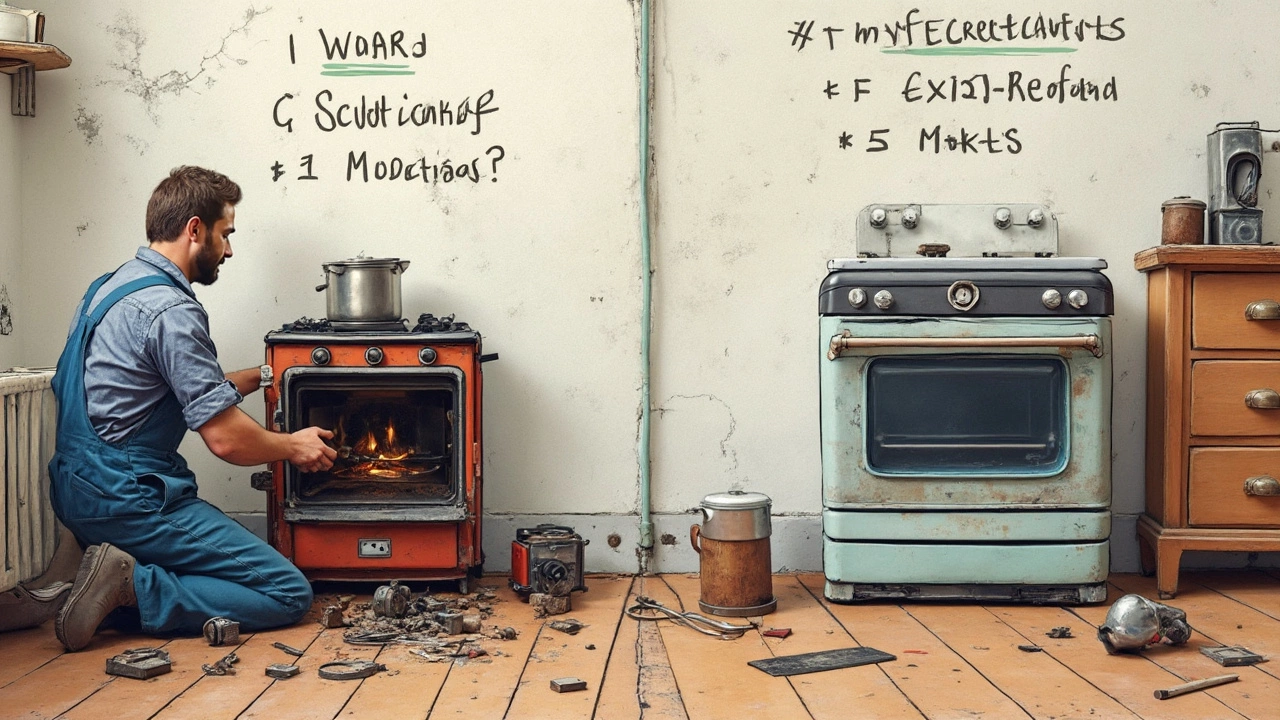An oven that’s been running smoothly for eight years suddenly stops heating, and your lasagna dreams hit a wall. It happens more often than you’d think. So does it make sense to fix it, or are you just throwing cash at a lost cause?
The first thing most people don’t realize is that electric ovens can quietly chug along for 10 to 15 years—sometimes even longer if you’re lucky and treat them right. But once they hit the 8-year mark, stuff does start breaking: maybe the heating element gives out, the control board glitches, or the thermostat goes haywire. Little things pile up, and even tiny repairs can make you pause and wonder, “Is it worth it?”
The truth: it’s easy to assume that older ovens are bound for the landfill, but that’s not always the smartest move. Some repairs are cheap and simple—think replacing a $30 element or cleaning a junked-up sensor. Others might hit you for hundreds, and before you know it, you’re debating the price of fixing versus buying a whole new setup. It’s not always an obvious call, but understanding what goes wrong (and how bad it really is) can save you a lot of money—and headache—in the long run.
- Oven Lifespan: Fact vs. Myth
- Common Problems with Older Ovens
- Repair Costs vs. Replacement Costs
- How to Decide—Fix or Move On?
Oven Lifespan: Fact vs. Myth
Here’s something most folks get wrong: ovens don’t just up and die at a set age. In reality, the average electric oven lasts about 13 years, give or take, according to real appliance surveys from repair pros and industry groups. Plenty of ovens out there are going strong after 10 years, especially if they’ve had even basic care. So, eight years isn’t exactly ancient by appliance standards.
Electric oven repair becomes more relevant around the 8–15 year mark, because that’s when small things—heating elements, sensors, electronics—start to croak. But don’t confuse normal wear-and-tear with a “use-by” date.
Check out this quick breakdown from the National Association of Home Builders (NAHB):
| Appliance | Average Lifespan (Years) |
|---|---|
| Electric Oven | 13 |
| Gas Oven | 15 |
| Dishwasher | 9 |
| Refrigerator | 13 |
So if someone tells you an 8-year-old oven should just be trashed, there’s a solid chance they’re wrong. Still, ovens with heavy daily use (baking, roasting, broiling every day) will show their age faster than the once-a-month type. And no matter what, regular cleaning and not slamming the door goes a long way.
"Most ovens fail not because of age, but because small, fixable issues get ignored for too long." — Paul Ryder, senior tech at a national appliance service company
The biggest myth? That new ovens are always better or that repair is a waste of time and money. Modern ovens do have fancy features, but the core heating technology hasn’t changed much in decades. Sometimes, the older models even outlast the newer, digital-loaded versions.
Common Problems with Older Ovens
Once an electric oven hits that 8-year mark, certain issues just start popping up. The most common culprits almost always tie back to a handful of parts wearing out from everyday use. It’s not about mistreatment—appliances just have parts that tire out, like the rest of us.
- Heating element failure: This is usually the front-runner. Ovens that won’t heat up or heat unevenly often have a worn-out bake or broil element. Swapping one out is the closest you’ll get to a quick fix.
- Faulty temperature sensor: If your oven gets too hot or not hot enough, blame the temperature sensor. Because it controls heat cycles, a bad sensor can make baking nearly impossible.
- Control board breakdown: These can fry after years of power surges or internal wear. Replacing a control board is easy for a pro but costly—sometimes up to half the price of a new unit.
- Door gasket issues: When the door seal cracks or wears down, heat escapes. That makes the oven work harder and use more energy, and can totally mess up your meal.
- Unresponsive keypad or knobs: Buttons and dials can get finicky as they age. Press a button and get nothing? Time for a replacement or deep clean.
Factory stats from a 2024 appliance industry survey showed that the four most common repairs for home ovens are heating element replacement, sensor issues, bad ignition switches, and loose wiring. Here’s a quick look how often these trouble spots show up on repairs:
| Problem | Percent of Repairs |
|---|---|
| Heating Element | 38% |
| Temperature Sensor | 24% |
| Ignition Switch/Control Board | 21% |
| Door Gasket/Seal | 17% |
One respected appliance repair tech, Tom Harris, put it plainly:
“If your oven still heats up and the cost of repair isn’t over a third of replacement, fix it. Most mid-age ovens just need a little love.”
The main takeaway? Most problems at this age involve replaceable parts, not full breakdowns. So before you write off your oven, see if it just needs a basic fix. That’s where you get the biggest bang for your buck in electric oven repair.

Repair Costs vs. Replacement Costs
Before you pay for repairs or go shopping for a new oven, you’ve got to look at the numbers. Here’s the thing: fixing an 8-year-old oven doesn’t always break the bank. On average, electric oven repair runs anywhere from $100 to $400, depending on the part that’s busted and who’s doing the work. Swapping out a faulty bake element or a bad thermostat is usually on the cheaper end. But once you get into control board problems or wiring issues, the bill climbs fast.
If you’re thinking about ditching your old oven altogether, a basic new electric oven starts around $500. Decent mid-range options usually hit $700 to $1,200, and it’s easy to blow past $2,000 if you want a top-of-the-line model with bells and whistles. Don’t forget to tack on installation or haul-away fees, which could add another $100 or so.
| Repair Type | Average Cost (USD) |
|---|---|
| Bake Element Replacement | $120 - $250 |
| Thermostat Replacement | $100 - $200 |
| Control Board Repair | $200 - $400 |
| Door Seal Replacement | $80 - $150 |
| Full Oven Replacement (basic) | $500 - $700 |
| Full Oven Replacement (mid-range) | $700 - $1,200 |
Here’s a tip: if the repair’s going to cost more than half the price of a new oven, it’s usually smarter to invest in a replacement—especially if you’ve already spent money fixing other parts. But if this is your first repair and everything else works fine, you might get another few good years with a quick fix.
- Add up any past repair bills to see your total spend on keeping the oven alive.
- Ask about any warranty left—parts are sometimes covered long after labor is up.
- Factor in hidden costs with a new oven, like upgraded power lines or fitting changes for a different size.
The real answer depends on what’s wrong, how much hassle you can tolerate, and how attached you are to your current kitchen lineup. Do a little math before giving up on your old oven—it could save you a chunk of change.
How to Decide—Fix or Move On?
If your oven is eight years old and suddenly acting up, you’ve got a choice: repair it or toss it. Not every problem means the end of the road. Here’s how I break down the decision—without second-guessing yourself for weeks.
First, grab your model number and check what’s actually wrong. Sometimes, a quick YouTube search will show you that replacing, say, a bake element or a thermostat is cheap and takes a screwdriver plus ten minutes. When the part is only $35 and you can do it yourself, it’s a no-brainer.
But if the issue is more serious—like a busted main control board, which might cost $300+ just for the part—compare that to a brand-new oven. Right now, a basic electric oven runs $500 to $900. If your repair estimate is more than half of what a new one costs, lean towards replacing. No repair shop will tell you this directly, but warranty coverage on big repairs often ends after 90 days.
- Add up the age of the oven, the repair cost, and any funky symptoms (does it cook unevenly, cycle off too early, or make strange noises?). If you’re facing frequent repairs, it’s a sign your oven’s tired—and may keep draining your wallet.
- Consider energy usage. Newer ovens have better insulation and tech, so you could actually save on your power bill. The government claims you can knock off $50 to $100 a year in savings with modern appliances.
- Don’t forget how you use your oven. If you bake every weekend, reliability matters more, and an upgrade makes sense. If it only gets hot during holidays, a quick repair might be all you need.
Here’s a super quick cheat sheet:
- If the electric oven repair is under $150 and it’s the first major problem, repair it.
- If repairs start adding up, or the oven has quirks that bug you all the time, start shopping for a new one.
It really comes down to math and how much kitchen hassle you’re willing to put up with. The fix-or-replace question isn’t about the age alone—it’s everything stacked up together.
